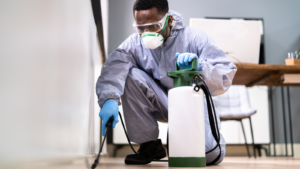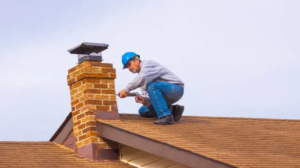An exterminator eliminates pests from homes and businesses. Their job includes:
- Inspecting properties for infestations.
- Applying pesticides and other treatments.
- Advising clients on long-term prevention.
Exterminator Bakersfield may work in residential, commercial, and industrial environments. They may be self-employed or employed by a pest control company. They often wear protective gear when dealing with chemicals.

When pests invade your home, you want to eliminate them as quickly as possible. When you search for a company to help, you may come across terms like “pest control professionals” and “exterminators.” You will also see options for perimeter pest control and general pest control. These are all different types of services, and you will need to decide which one is right for you.
An exterminator typically offers a more immediate and powerful solution to pest infestations. They use harsh chemicals to clear out the bugs, and they can often provide a quick fix. Exterminators are great for dealing with extreme pest problems, such as severe termite or cockroach infestations.
Pest control experts, on the other hand, are a better choice for those with mild to moderate pest issues. Pest control specialists can offer a more long-term solution, and they work with you to prevent pests from returning. They can advise you on landscaping tactics, cleaning strategies, and other ways to keep pests away from your home.
When choosing a residential pest control provider, make sure to consider costs, pest treatments offered, contracts and customer reviews. Look for a provider with strong online ratings and a satisfaction guarantee. A good provider will be transparent about their fees and will clearly explain any additional charges, such as those for a recurring plan. Recurring plans are more cost-effective, and they often include a service guarantee that covers re-treatments at no extra charge in the event of a problem. One-time treatment plans generally do not come with this guarantee. It’s also important to choose a company that is local to you so that they can quickly and effectively treat your pest problem. This will save you time and money in the long run. A reputable company will be licensed, insured, and certified to provide services in your area. They will also provide a free quote for your pest removal needs. They will also provide a thorough inspection of your property to identify the source of the pests and offer the best solution for you.
Commercial
Exterminators work with businesses such as restaurants, hotels, and hospitals to help them control pests. These pests can damage merchandise and cause health problems for employees or customers. Exterminators use chemicals and traps to manage and eliminate pests in these types of environments. Exterminators also work to prevent pests from returning after treatment.
Exterminator services for commercial properties usually begin with a thorough inspection of the property. This includes examining the interior and exterior of the building as well as checking for potential entry points. Once the inspection is complete, an exterminator can create a pest management plan for the business. This may include educating employees on proper sanitation practices, repairing any structural issues that contribute to the pest problem, and providing ongoing pest prevention services.
Most people hire an exterminator when they have a serious pest infestation problem such as termites, cockroaches, fleas, or ants. These pests can cause costly damage to homes and businesses, and they can be very difficult to get rid of. Exterminators are usually required to use strong chemicals that can be harmful to humans and pets. They may also need to spray a large area in order to eradicate the pests completely.
While some pests are more dangerous than others, all can pose a health threat. For example, mosquitoes can spread encephalitis, West Nile virus, Zika virus, dengue fever, and malaria. Fleas can spread typhus, plague, and Rocky Mountain spotted fever, while ticks can cause Lyme disease. While some pests can be managed without the need for extermination, it is important to know when a professional should be called.
A good exterminator will usually have a realistic personality type, and they will be able to follow strict safety protocols when working with hazardous chemicals. They will also be able to assess the severity of the pest infestation and determine which treatments will work best for each situation. They will also be able to provide long-term prevention methods that are less damaging to the environment and human health. Most importantly, a good exterminator will always be able to provide a service satisfaction guarantee for their work.
Industrial
Exterminators work in a variety of environments, including residential and commercial settings. They may use chemical treatments to eliminate pests in homes and businesses, or they may use natural or organic methods such as traps or pheromones. They also provide preventative services, such as educating clients on sanitation and sealing cracks and openings in structures to prevent pests from entering.
Pest infestations can be extremely dangerous to people and pets, and they can also cause severe damage to property. To protect your family and home, it’s important to hire a professional exterminator in Southlake to eradicate these pests before they become a serious problem. They will conduct a thorough inspection to identify the type of pests and assess the extent of their infestation. They will then recommend the appropriate treatment for your situation.
In addition to performing insect extermination, pest control professionals can also help with rodent extermination and other pests such as ants, bed bugs, and bees. Some companies even offer mosquito extermination services. Exterminators use various techniques to control pests, such as pheromone traps and insect growth regulators, to keep them out of the house. Some even use ultrasonic sound waves to repel pests.
An exterminator will inspect the area infested by pests to determine the scope of the problem and how best to treat it. They will examine the building or structure for entry points, breeding sites, and feeding areas. They will also look at the extent of any damages that have been caused by the pests and determine what steps must be taken to reduce their presence in the future.
While some pests, such as termites, can be treated quickly, others, like cockroaches and oriental cockroaches, take more time to eradicate. This is because these pests often hide in places that are hard to reach, such as the back of cabinets, under sinks, and behind furniture. To find them, the exterminator must dismantle appliances and pull drawers to check for their presence. The exterminator will then use a mixture of baits and traps to eliminate the pests.
It is important for an exterminator to be able to communicate clearly with his or her client in order to understand the nature of the pest problem and how to treat it effectively. He or she will also need to be able to follow all safety procedures when applying any chemical treatments. These include wearing protective clothing, goggles, and respirators when necessary. In addition, the exterminator will need to be able to document their work and provide follow-up inspections as required by law.
Snakes
Snakes are a major cause of fear in people. They are also important predators and help keep rodent populations in check. However, they can be dangerous and should never be handled by anyone who is not trained to handle them properly. They can also bite and spread disease. If you find a snake in your home or garage, it is best to contact a professional to have them removed.
Snake removal specialists have the proper training and equipment to safely remove snakes. They will take the necessary precautions to prevent any further damage to your home or property. They will also recommend ways to keep the snakes away from your house.
The most common reason for a snake to enter a home is to look for food. They are often found in kitchens, basements and garages. Generally, snakes are not aggressive and will leave the area once they have found a meal. However, if they feel threatened or are cornered, they may bite.
Most snakes are carnivores and consume insects, small mammals and reptiles. Their specialized jaws and bodies enable them to swallow prey items 2 to 4 times larger than their own head. They also have the ability to digest live prey. Depending on the species, they can feed up to four times their own body weight each day. Being ectotherms, they require a constant supply of moisture.
Many snakes are able to camouflage themselves to blend in with their environment and avoid being seen by potential predators. Others use their tongues to taste the air around them for moisture and scents. Although snakes do not have eyes, they have good hearing and smell. They are also capable of producing a sound, called a rattle, by vibrating their scales.
The rattlesnake’s rattle is made of a series of hard segments that are added to as the snake sheds. When shaken, the rattle segments resound and create a rhythmic vibration that serves as an effective warning system to potential predators. Most snakes do not kill their prey, but rather subdue it and consume it alive, usually by constriction.



